GMC SAVANA 2007 Owner's Manual
Manufacturer: GMC, Model Year: 2007, Model line: SAVANA, Model: GMC SAVANA 2007Pages: 452, PDF Size: 2.68 MB
Page 281 of 452
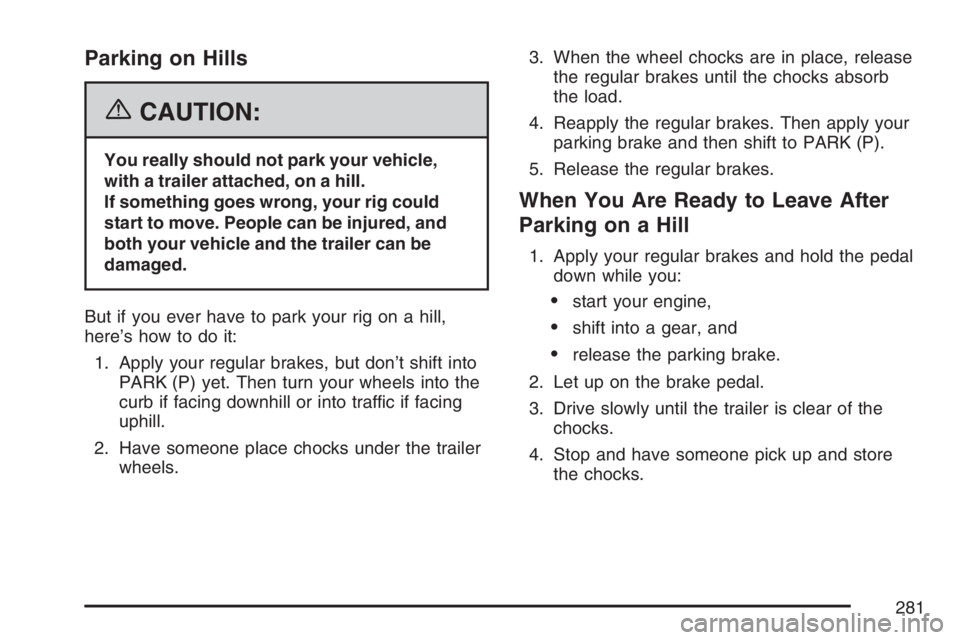
Parking on Hills
{CAUTION:
You really should not park your vehicle,
with a trailer attached, on a hill.
If something goes wrong, your rig could
start to move. People can be injured, and
both your vehicle and the trailer can be
damaged.
But if you ever have to park your rig on a hill,
here’s how to do it:
1. Apply your regular brakes, but don’t shift into
PARK (P) yet. Then turn your wheels into the
curb if facing downhill or into traffic if facing
uphill.
2. Have someone place chocks under the trailer
wheels.3. When the wheel chocks are in place, release
the regular brakes until the chocks absorb
the load.
4. Reapply the regular brakes. Then apply your
parking brake and then shift to PARK (P).
5. Release the regular brakes.
When You Are Ready to Leave After
Parking on a Hill
1. Apply your regular brakes and hold the pedal
down while you:
•start your engine,
•shift into a gear, and
•release the parking brake.
2. Let up on the brake pedal.
3. Drive slowly until the trailer is clear of the
chocks.
4. Stop and have someone pick up and store
the chocks.
281
Page 282 of 452
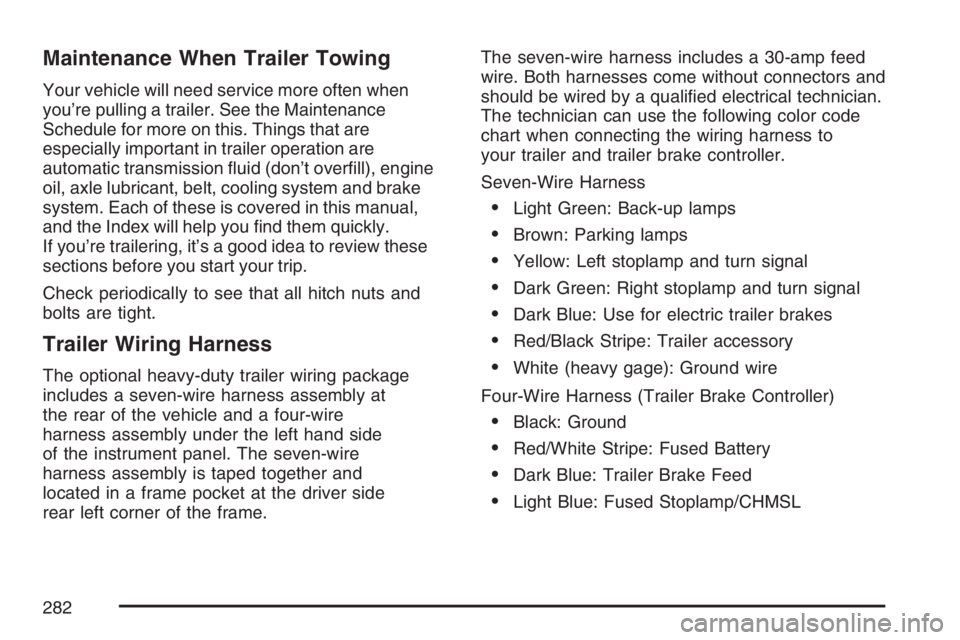
Maintenance When Trailer Towing
Your vehicle will need service more often when
you’re pulling a trailer. See the Maintenance
Schedule for more on this. Things that are
especially important in trailer operation are
automatic transmission fluid (don’t overfill), engine
oil, axle lubricant, belt, cooling system and brake
system. Each of these is covered in this manual,
and the Index will help you find them quickly.
If you’re trailering, it’s a good idea to review these
sections before you start your trip.
Check periodically to see that all hitch nuts and
bolts are tight.
Trailer Wiring Harness
The optional heavy-duty trailer wiring package
includes a seven-wire harness assembly at
the rear of the vehicle and a four-wire
harness assembly under the left hand side
of the instrument panel. The seven-wire
harness assembly is taped together and
located in a frame pocket at the driver side
rear left corner of the frame.The seven-wire harness includes a 30-amp feed
wire. Both harnesses come without connectors and
should be wired by a qualified electrical technician.
The technician can use the following color code
chart when connecting the wiring harness to
your trailer and trailer brake controller.
Seven-Wire Harness
•Light Green: Back-up lamps
•Brown: Parking lamps
•Yellow: Left stoplamp and turn signal
•Dark Green: Right stoplamp and turn signal
•Dark Blue: Use for electric trailer brakes
•Red/Black Stripe: Trailer accessory
•White (heavy gage): Ground wire
Four-Wire Harness (Trailer Brake Controller)
•Black: Ground
•Red/White Stripe: Fused Battery
•Dark Blue: Trailer Brake Feed
•Light Blue: Fused Stoplamp/CHMSL
282
Page 283 of 452
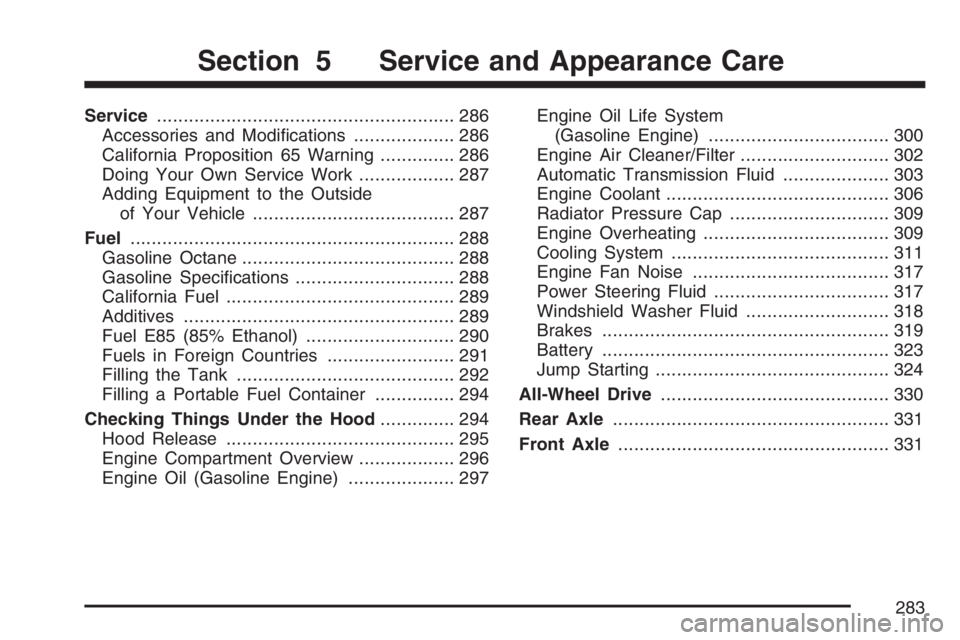
Service........................................................ 286
Accessories and Modifications................... 286
California Proposition 65 Warning.............. 286
Doing Your Own Service Work.................. 287
Adding Equipment to the Outside
of Your Vehicle...................................... 287
Fuel............................................................. 288
Gasoline Octane........................................ 288
Gasoline Specifications.............................. 288
California Fuel........................................... 289
Additives................................................... 289
Fuel E85 (85% Ethanol)............................ 290
Fuels in Foreign Countries........................ 291
Filling the Tank......................................... 292
Filling a Portable Fuel Container............... 294
Checking Things Under the Hood.............. 294
Hood Release........................................... 295
Engine Compartment Overview.................. 296
Engine Oil (Gasoline Engine).................... 297Engine Oil Life System
(Gasoline Engine).................................. 300
Engine Air Cleaner/Filter............................ 302
Automatic Transmission Fluid.................... 303
Engine Coolant.......................................... 306
Radiator Pressure Cap.............................. 309
Engine Overheating................................... 309
Cooling System......................................... 311
Engine Fan Noise..................................... 317
Power Steering Fluid ................................. 317
Windshield Washer Fluid........................... 318
Brakes...................................................... 319
Battery...................................................... 323
Jump Starting............................................ 324
All-Wheel Drive........................................... 330
Rear Axle.................................................... 331
Front Axle................................................... 331
Section 5 Service and Appearance Care
283
Page 284 of 452
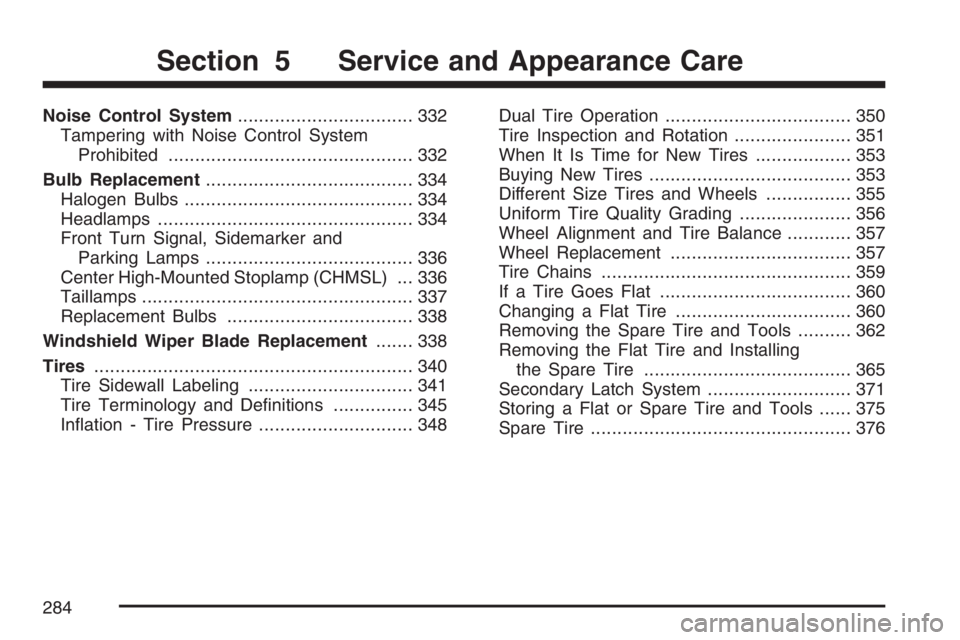
Noise Control System................................. 332
Tampering with Noise Control System
Prohibited.............................................. 332
Bulb Replacement....................................... 334
Halogen Bulbs........................................... 334
Headlamps................................................ 334
Front Turn Signal, Sidemarker and
Parking Lamps....................................... 336
Center High-Mounted Stoplamp (CHMSL) ... 336
Taillamps................................................... 337
Replacement Bulbs................................... 338
Windshield Wiper Blade Replacement....... 338
Tires............................................................ 340
Tire Sidewall Labeling............................... 341
Tire Terminology and Definitions............... 345
Inflation - Tire Pressure............................. 348Dual Tire Operation................................... 350
Tire Inspection and Rotation...................... 351
When It Is Time for New Tires.................. 353
Buying New Tires...................................... 353
Different Size Tires and Wheels................ 355
Uniform Tire Quality Grading..................... 356
Wheel Alignment and Tire Balance............ 357
Wheel Replacement.................................. 357
Tire Chains............................................... 359
If a Tire Goes Flat.................................... 360
Changing a Flat Tire................................. 360
Removing the Spare Tire and Tools.......... 362
Removing the Flat Tire and Installing
the Spare Tire....................................... 365
Secondary Latch System........................... 371
Storing a Flat or Spare Tire and Tools...... 375
Spare Tire................................................. 376
Section 5 Service and Appearance Care
284
Page 285 of 452

Appearance Care........................................ 377
Cleaning the Inside of Your Vehicle.......... 377
Fabric/Carpet............................................. 378
Instrument Panel, Vinyl, and Other
Plastic Surfaces..................................... 379
Care of Safety Belts.................................. 380
Weatherstrips............................................ 380
Washing Your Vehicle............................... 380
Cleaning Exterior Lamps/Lenses................ 381
Finish Care............................................... 381
Windshield and Wiper Blades.................... 382
Aluminum Wheels...................................... 382
Tires......................................................... 383
Sheet Metal Damage................................. 383
Finish Damage.......................................... 383
Underbody Maintenance............................ 384Chemical Paint Spotting............................ 384
Vehicle Care/Appearance Materials............ 385
Vehicle Identi�cation.................................. 386
Vehicle Identification Number (VIN)........... 386
Service Parts Identification Label............... 386
Electrical System........................................ 387
Add-On Electrical Equipment..................... 387
Headlamp Wiring....................................... 387
Windshield Wiper Fuses............................ 387
Fuses and Circuit Breakers....................... 387
Floor Console Fuse Block......................... 388
Engine Compartment Fuse Block............... 390
Capacities and Speci�cations.................... 393
Section 5 Service and Appearance Care
285
Page 286 of 452
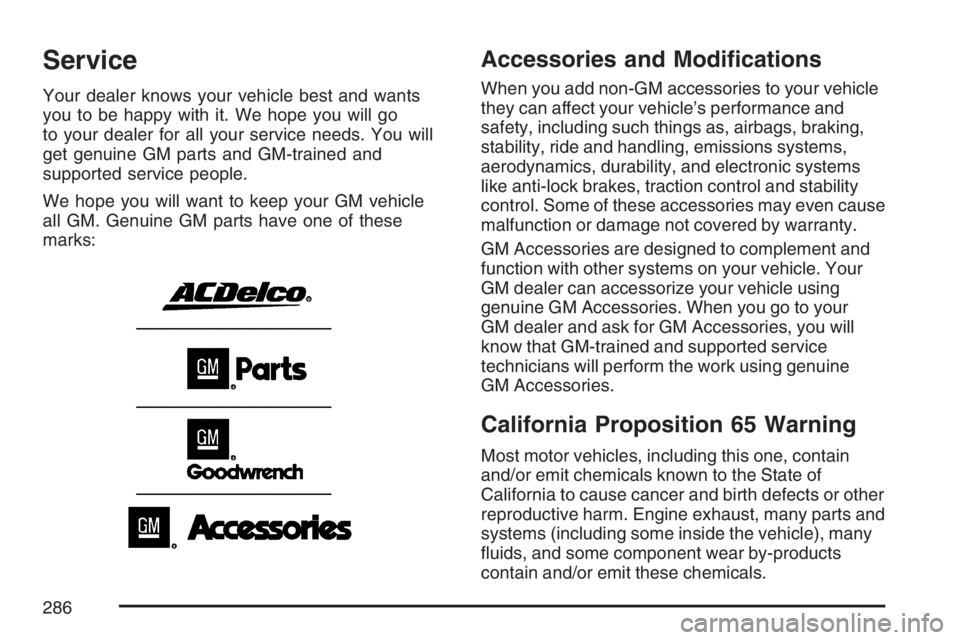
Service
Your dealer knows your vehicle best and wants
you to be happy with it. We hope you will go
to your dealer for all your service needs. You will
get genuine GM parts and GM-trained and
supported service people.
We hope you will want to keep your GM vehicle
all GM. Genuine GM parts have one of these
marks:
Accessories and Modi�cations
When you add non-GM accessories to your vehicle
they can affect your vehicle’s performance and
safety, including such things as, airbags, braking,
stability, ride and handling, emissions systems,
aerodynamics, durability, and electronic systems
like anti-lock brakes, traction control and stability
control. Some of these accessories may even cause
malfunction or damage not covered by warranty.
GM Accessories are designed to complement and
function with other systems on your vehicle. Your
GM dealer can accessorize your vehicle using
genuine GM Accessories. When you go to your
GM dealer and ask for GM Accessories, you will
know that GM-trained and supported service
technicians will perform the work using genuine
GM Accessories.
California Proposition 65 Warning
Most motor vehicles, including this one, contain
and/or emit chemicals known to the State of
California to cause cancer and birth defects or other
reproductive harm. Engine exhaust, many parts and
systems (including some inside the vehicle), many
fluids, and some component wear by-products
contain and/or emit these chemicals.
286
Page 287 of 452

Doing Your Own Service Work
{CAUTION:
You can be injured and your vehicle could
be damaged if you try to do service work
on a vehicle without knowing enough
about it.
Be sure you have sufficient knowledge,
experience, the proper replacement
parts, and tools before you attempt any
vehicle maintenance task.
Be sure to use the proper nuts, bolts,
and other fasteners. English and metric
fasteners can be easily confused. If you
use the wrong fasteners, parts can later
break or fall off. You could be hurt.
If you want to do some of your own service work,
you will want to use the proper service manual.
It tells you much more about how to service your
vehicle than this manual can. To order the
proper service manual, seeService Publications
Ordering Information on page 437.Your vehicle has an airbag system. Before
attempting to do your own service work, see
Servicing Your Airbag-Equipped Vehicle on
page 96.
You should keep a record with all parts receipts
and list the mileage and the date of any service
work you perform. SeeMaintenance Record
on page 413.
Adding Equipment to the Outside of
Your Vehicle
Things you might add to the outside of your
vehicle can affect the airflow around it. This may
cause wind noise and affect windshield washer
performance. Check with your dealer before
adding equipment to the outside of your vehicle.
287
Page 288 of 452
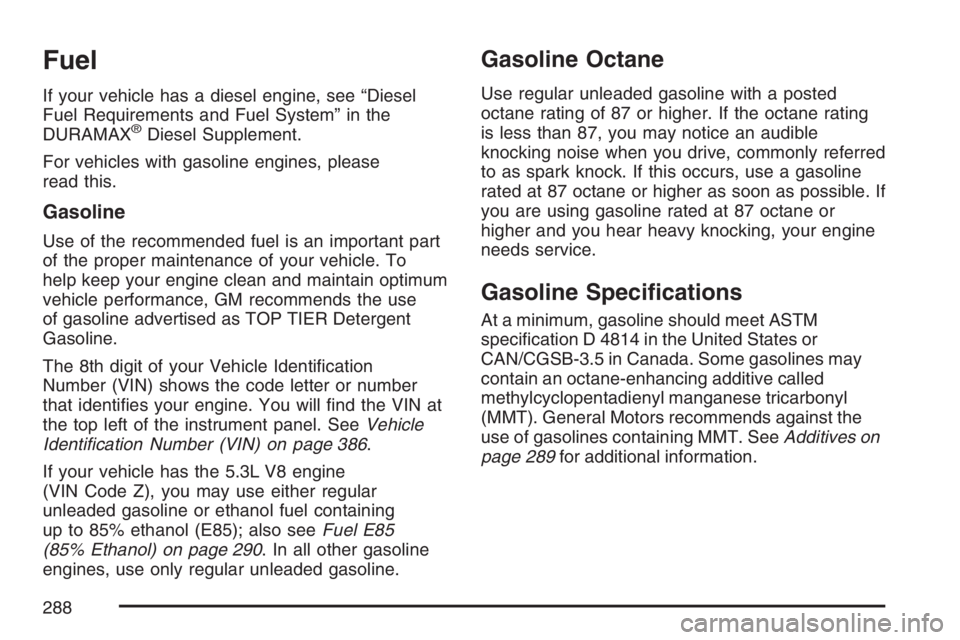
Fuel
If your vehicle has a diesel engine, see “Diesel
Fuel Requirements and Fuel System” in the
DURAMAX
®Diesel Supplement.
For vehicles with gasoline engines, please
read this.
Gasoline
Use of the recommended fuel is an important part
of the proper maintenance of your vehicle. To
help keep your engine clean and maintain optimum
vehicle performance, GM recommends the use
of gasoline advertised as TOP TIER Detergent
Gasoline.
The 8th digit of your Vehicle Identification
Number (VIN) shows the code letter or number
that identifies your engine. You will find the VIN at
the top left of the instrument panel. SeeVehicle
Identi�cation Number (VIN) on page 386.
If your vehicle has the 5.3L V8 engine
(VIN Code Z), you may use either regular
unleaded gasoline or ethanol fuel containing
up to 85% ethanol (E85); also seeFuel E85
(85% Ethanol) on page 290. In all other gasoline
engines, use only regular unleaded gasoline.
Gasoline Octane
Use regular unleaded gasoline with a posted
octane rating of 87 or higher. If the octane rating
is less than 87, you may notice an audible
knocking noise when you drive, commonly referred
to as spark knock. If this occurs, use a gasoline
rated at 87 octane or higher as soon as possible. If
you are using gasoline rated at 87 octane or
higher and you hear heavy knocking, your engine
needs service.
Gasoline Speci�cations
At a minimum, gasoline should meet ASTM
specification D 4814 in the United States or
CAN/CGSB-3.5 in Canada. Some gasolines may
contain an octane-enhancing additive called
methylcyclopentadienyl manganese tricarbonyl
(MMT). General Motors recommends against the
use of gasolines containing MMT. SeeAdditives on
page 289for additional information.
288
Page 289 of 452
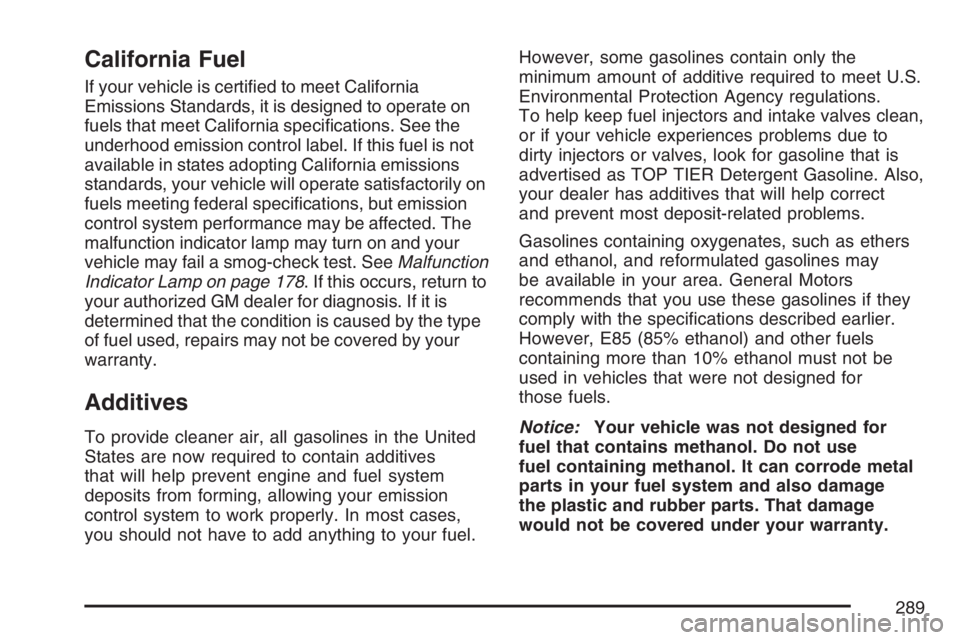
California Fuel
If your vehicle is certified to meet California
Emissions Standards, it is designed to operate on
fuels that meet California specifications. See the
underhood emission control label. If this fuel is not
available in states adopting California emissions
standards, your vehicle will operate satisfactorily on
fuels meeting federal specifications, but emission
control system performance may be affected. The
malfunction indicator lamp may turn on and your
vehicle may fail a smog-check test. SeeMalfunction
Indicator Lamp on page 178. If this occurs, return to
your authorized GM dealer for diagnosis. If it is
determined that the condition is caused by the type
of fuel used, repairs may not be covered by your
warranty.
Additives
To provide cleaner air, all gasolines in the United
States are now required to contain additives
that will help prevent engine and fuel system
deposits from forming, allowing your emission
control system to work properly. In most cases,
you should not have to add anything to your fuel.However, some gasolines contain only the
minimum amount of additive required to meet U.S.
Environmental Protection Agency regulations.
To help keep fuel injectors and intake valves clean,
or if your vehicle experiences problems due to
dirty injectors or valves, look for gasoline that is
advertised as TOP TIER Detergent Gasoline. Also,
your dealer has additives that will help correct
and prevent most deposit-related problems.
Gasolines containing oxygenates, such as ethers
and ethanol, and reformulated gasolines may
be available in your area. General Motors
recommends that you use these gasolines if they
comply with the specifications described earlier.
However, E85 (85% ethanol) and other fuels
containing more than 10% ethanol must not be
used in vehicles that were not designed for
those fuels.
Notice:Your vehicle was not designed for
fuel that contains methanol. Do not use
fuel containing methanol. It can corrode metal
parts in your fuel system and also damage
the plastic and rubber parts. That damage
would not be covered under your warranty.
289
Page 290 of 452
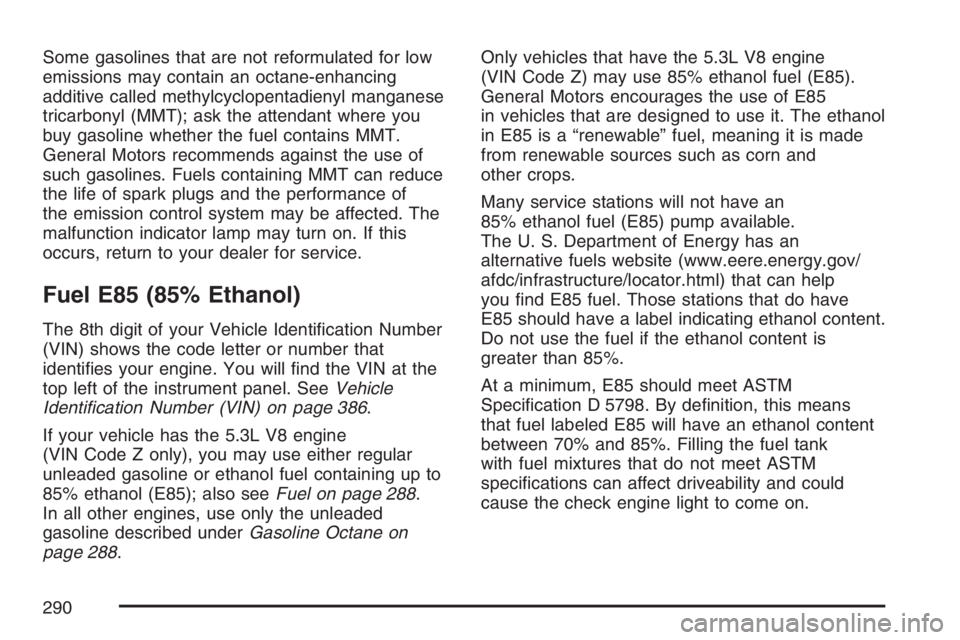
Some gasolines that are not reformulated for low
emissions may contain an octane-enhancing
additive called methylcyclopentadienyl manganese
tricarbonyl (MMT); ask the attendant where you
buy gasoline whether the fuel contains MMT.
General Motors recommends against the use of
such gasolines. Fuels containing MMT can reduce
the life of spark plugs and the performance of
the emission control system may be affected. The
malfunction indicator lamp may turn on. If this
occurs, return to your dealer for service.
Fuel E85 (85% Ethanol)
The 8th digit of your Vehicle Identification Number
(VIN) shows the code letter or number that
identifies your engine. You will find the VIN at the
top left of the instrument panel. SeeVehicle
Identi�cation Number (VIN) on page 386.
If your vehicle has the 5.3L V8 engine
(VIN Code Z only), you may use either regular
unleaded gasoline or ethanol fuel containing up to
85% ethanol (E85); also seeFuel on page 288.
In all other engines, use only the unleaded
gasoline described underGasoline Octane on
page 288.Only vehicles that have the 5.3L V8 engine
(VIN Code Z) may use 85% ethanol fuel (E85).
General Motors encourages the use of E85
in vehicles that are designed to use it. The ethanol
in E85 is a “renewable” fuel, meaning it is made
from renewable sources such as corn and
other crops.
Many service stations will not have an
85% ethanol fuel (E85) pump available.
The U. S. Department of Energy has an
alternative fuels website (www.eere.energy.gov/
afdc/infrastructure/locator.html) that can help
you find E85 fuel. Those stations that do have
E85 should have a label indicating ethanol content.
Do not use the fuel if the ethanol content is
greater than 85%.
At a minimum, E85 should meet ASTM
Specification D 5798. By definition, this means
that fuel labeled E85 will have an ethanol content
between 70% and 85%. Filling the fuel tank
with fuel mixtures that do not meet ASTM
specifications can affect driveability and could
cause the check engine light to come on.
290